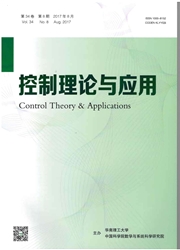

 中文摘要:
中文摘要:
基于一致性理论,在有向通讯拓扑结构下对多航天器系统相对轨道及姿态的耦合协同控制问题进行了研究.本文考虑近地航天器相对轨道的非线性方程以及用罗德里格参数描述的航天器姿态运动方程.建立了考虑控制输入耦合的六自由度航天器运动模型.在仅有部分跟随航天器可获取参考状态(记为领航航天器)的情形下,针对航天器存在未建模动态以及外部环境干扰等问题,提出了一种基于切比雪夫神经网络(Chebyshev neural networks.CNN)的自适应增益控制律,使得各跟随航天器在轨道交会的同时姿态保持一致.因为每个航天器上的控制算法仅依赖其自身及相邻航天器的信息,因此控制算法是分布式的.同时考虑到航天器之间的相对速度及相对角速度难以测量,提出了无需相对速度及角速度信息的分布式自适应协同控制律使得各航天器保持一定的队形且具有期望的相对指向.最后对6颗航天器的编队飞行进行了仿真分析,仿真结果表明本文设计的分布式自适应协同控制律是有效可行的.
 英文摘要:
英文摘要:
According to the consensus theory, the coupled-cooperative control for relative orbits and attitudes of a multispacecraft system is investigated under a directed communication topology. Considering the nonlinear equations for the relative orbits of near-earth spacecraft and the attitude motion equations in terms of the modified Rodriguez parameters (MRP), we build six-degrees-of-freedom (6DOF) motion equations with coupled control input and unknown nonlinearities and external disturbance. When the reference state (label of the leader spacecraft) is available only to a partial number of the follower spacecrafts, we develop an adaptive gain control algorithm based on Chebyshev neural networks, which can let a fleet of followers rendezvous at a point with the same attitude. The proposed distributed algorithm for each following spacecraft is only dependent on the information of itself and its neighboring spacecraft. Because the relative velocities and relative angular velocities among the follower spacecrafts are difficult to be measured, we propose a distributed-coupled- adaptive-control algorithm without using neighboring velocities and angular velocities, so that all follower spacecrafts maintain a desired formation and relative attitudes. Simulation results of the formation-flight of six spacecrafts are carried out to study the effectiveness of the proposed control scheme.
 同期刊论文项目
同期刊论文项目
 同项目期刊论文
同项目期刊论文
 Distributed containment control for Lagrangian networks with parametric uncertainties under a direct
Distributed containment control for Lagrangian networks with parametric uncertainties under a direct Distributed coordination for second-order multi-agent systems with nonlinear dynamics using only rel
Distributed coordination for second-order multi-agent systems with nonlinear dynamics using only rel Distributed adaptive coordination for multiple Lagrangian systems under a directed graph without usi
Distributed adaptive coordination for multiple Lagrangian systems under a directed graph without usi Nonlinear dynamics and reconfiguration control of two-satellite Coulomb tether formation at libratio
Nonlinear dynamics and reconfiguration control of two-satellite Coulomb tether formation at libratio Nonlinear dynamics and station-keeping control of a rotating tethered satellite system in halo orbit
Nonlinear dynamics and station-keeping control of a rotating tethered satellite system in halo orbit Distributed containment control for Lagrangiannetworks with parametric uncertainties under a directe
Distributed containment control for Lagrangiannetworks with parametric uncertainties under a directe Decentralized adaptive output feedback attitude synchronization tracking control of satellite format
Decentralized adaptive output feedback attitude synchronization tracking control of satellite format Decentralised adaptive output feedbacksynchronisation tracking control of spacecraft formation flyin
Decentralised adaptive output feedbacksynchronisation tracking control of spacecraft formation flyin 期刊信息
期刊信息
